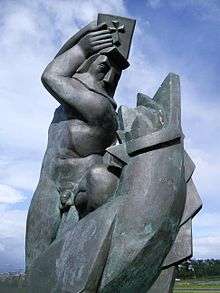Sæmundr fróði

Sæmundur Sigfússon (or Sæmundur fróði) (Sæmundur the Learned) (1056–1133) was an Icelandic priest and scholar. Sæmundur is known to have studied abroad. Previously it has generally been held that he studied in France, but modern scholars rather believe his studies were carried out in Franconia. In Iceland he founded a long-lived school at Oddi. He was a member of the Oddaverjar clan and had the son Loftur Sæmundsson.
Sæmundur wrote a work, probably in Latin, on the history of Norwegian kings. The work is now lost but was used as a source by later authors, including Snorri Sturluson. The poem Nóregs konungatal summarizes Sæmundur's work. The authorship of the Poetic Edda, or, more plausibly, just the editor's role in the compilation, was traditionally attributed to Sæmundur but is not accepted today.
In Icelandic folklore, Sæmundur is a larger-than-life character who repeatedly tricks the Devil into doing his bidding. For example, in one famous story Sæmundur made a pact with the Devil that the Devil should bring him home to Iceland from Europe on the back of a seal. Sæmundur escaped a diabolical end when, on arrival, he hit the seal on the head with the Bible, killing it, and stepping safely ashore.[1]
Although the above is a commonly told story about Sæmundur and his association with the Black School (Svartskóli), there are several others.[2] In one account, Sæmundur sailed abroad to learn the Dark Arts, but there was no schoolmaster present. Every time the students requested information regarding the arts, books about the subject would be provided the next morning or otherwise be written up on the walls.[3] Above the entrance to the school, it was written: "You may come in; your soul is lost." There was also a law that forbade anyone to study at the school for more than three years. Whenever the students left in a given year, they had to leave at the same time. The devil would keep the last one remaining, and so they always drew lots to determine who would be the last one to leave. On more than one occasion the lot fell on Sæmundur, and so he remained longer than the law permitted.[4] One day, Bishop Jón was traveling through Rome and passed nearby. He found out that Sæmundur was trapped in the Black School, so he offered him advice on how to escape as long as he returned to Iceland and behaved as a good Christian. Sæmundur agreed, but as he and Bishop Jón were leaving the school, the Devil reached up and grabbed Bishop Jón's cloak. Bishop Jón escaped, but the Devil trapped Sæmundur and made him a deal—if Sæmundur could hide for three days, he would be able to return to Iceland. Ultimately, Sæmundur was successful in hiding, and he presumably returned.[5]
Another account explains that when Sæmundur left the Black School, he sewed a leg of mutton into his cloak, and he followed the rushing group out of the doors. When Sæmundur was near the exit, the Devil reached up to grab his cloak but only grabbed the leg that was sewn into the clothing. Sæmundur then dropped the cloak and ran, saying: "He grabbed, but I slipped away!".[6]
References
- ↑ Gísli Sigurðsson, 'Icelandic National Identity: From Romanticism to Tourism', in Making Europe in Nordic Contexts, ed. by Pertti J. Anttonen, NIF Publications, 35 (Turku: Nordic Institute of Folklore, University of Turku, 1996), pp. 41--76 (p. 52).
- ↑ Stephen Flowers, 'Icelandic Magic: Practical Secrets of the Northern Grimoires. Vermont: Inner Traditions, 2016, pp. 50-52.
- ↑ Stephen Flowers, 'Icelandic Magic: Practical Secrets of the Northern Grimoires. Vermont: Inner Traditions, 2016, pp. 51.
- ↑ Stephen Flowers, 'Icelandic Magic: Practical Secrets of the Northern Grimoires. Vermont: Inner Traditions, 2016, pp. 51.
- ↑ Stephen Flowers, 'Icelandic Magic: Practical Secrets of the Northern Grimoires. Vermont: Inner Traditions, 2016, pp. 51.
- ↑ Stephen Flowers, 'Icelandic Magic: Practical Secrets of the Northern Grimoires. Vermont: Inner Traditions, 2016, pp. 51-52.
- Aðalsteinsson, Jón Hnefill (1994). "Sæmundr Fróði: a medieval master of magic". Arv: Nordic Yearbook of Folklore. 50: 117–32.
- Paasche, Fredrik (1956). Norsk Litteraturhistorie I: Norges og Islands Litteratur (2nd ed.). Oslo: Aschehoug. pp. 273–6.